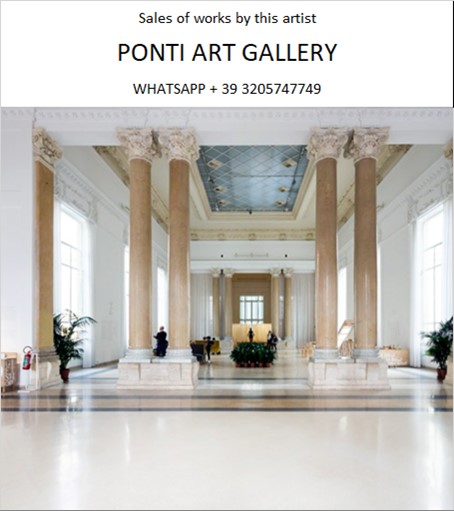Ponti Art Gallery is interested in buying and selling works
of art by this artist.

John Bradley-Storrs Biography
John Henry Bradley Storrs, known as John Bradley Storrs and John H. Storrs, was an American modernist sculptor whose work is celebrated for its innovative integration of architecture and sculpture, particularly within the Art Deco movement. Born on June 25, 1885, in Chicago, Illinois, Storrs was the son of architect D.W. Storrs. His early life was marked by personal tragedy with the loss of his brother William at a young age, which led to his mother, Hannah Bradley Storrs, being particularly protective of him. This protection delayed his formal education, as he did not begin school until he was nine years old and initially struggled with reading and writing.
Storrs' artistic journey began at the Chicago Manual Training School, where he discovered his passion for sculpture through woodworking classes. This early exposure to creating physical forms would become a significant influence on his artistic expression. After graduating in 1905, Storrs embarked on a trip to Europe, which was a promise fulfilled by his parents. During his travels, he visited his sister in Berlin and was advised to study sculpture with Arthur Bock in Hamburg. Bock's teachings on unity in design resonated with Storrs and would later be reflected in his own work.
Upon returning to Chicago in 1907, Storrs worked in his family's business but continued to pursue his artistic ambitions by taking night classes. His dedication to sculpture led him to the School of the Museum of Fine Arts in Boston in 1909, where he studied under Bela Pratt. However, finding the academic style too restrictive, Storrs sought a more modern approach to his art. This quest took him to the Pennsylvania Academy of the Fine Arts to study under Charles Grafly, but once again, the classical training did not satisfy his creative aspirations.
In 1911, Storrs moved to Paris, a city that was at the forefront of the modern art movement. There, he found a mentor in Auguste Rodin, the most innovative sculptor of the time. Rodin's influence on Storrs was profound, particularly in his approach to mass, space, and planar surfaces. While in Paris, Storrs also became acquainted with modernist trends such as Cubism and Futurism, which would become central to his own artistic style.
Storrs' personal life also flourished in Paris, where he married French writer Marguerite Deville Chabrol in 1914. The couple bought a chateau in Mer, France, and Storrs would divide his time between France and the United States. His work began to gain recognition, with his first solo exhibition of sculpture and wood engravings presented at the Folsom Galleries in New York in 1920. His abstract sculpture was also featured in the Societé Anonyme's International Exhibition of Modern Art at the Brooklyn Museum in 1926.
The 1930s saw Storrs exploring abstract painting, with works that retained a sculptural quality and often suggested the human figure. However, World War II brought challenges for Storrs, as he was arrested twice by the German occupation forces in France and imprisoned as an enemy alien. After his release, he returned to his studio in Mer in a weakened state but continued to work until his death.
Storrs is perhaps best known for his late-career abstract works, which were often cast from unconventional materials such as aluminum and stainless steel. One of his most famous works is the Ceres sculpture atop the Chicago Board of Trade Building, which is a testament to his ability to harmonize sculpture with architectural design. The sculpture of Ceres, the Roman goddess of grain, was created to symbolize the building's function as a major grain exchange and is celebrated for its streamlined form and modern materials.
Throughout his career, Storrs developed a distinctive style that combined his interest in modernist movements with his architectural background. His work is featured in many American and European museums, and he is considered a key figure in the Art Deco movement. Storrs' legacy is that of an artist who sought to push the boundaries of traditional sculpture and create a new visual language that resonated with the modern age. He passed away on April 26, 1956, leaving behind a body of work that continues to inspire and captivate audiences.
John Bradley-Storrs Quotes and
Sales of Works
Ponti Art Gallery selects and deals with paintings by the
artist. Upon request, we provide free estimates and
evaluations, communicate prices, quotations, and current
market values.
If you are interested in BUYING or SELLING works by the
artist, contact us immediately.
If you wish to sell or receive an evaluation of the
works:
Send us a frontal photo of the painting, one of the back,
and one of the signature. Also, indicate the dimensions of
the work. Inform us about the purchase origin of the work
and any kind of available documentation (purchase
receipts, certificates of authenticity, publications). One
of our operators will respond to you on the same day. We
guarantee maximum confidentiality and extreme
professionalism.
If you wish to purchase works by the painter: Contact us
and let us know your request. We will inform you about the
available works. We also offer the possibility to
subscribe to our NEWSLETTER, through which you will be
informed at the beginning of each month about the latest
acquisitions of the art gallery.
You can send us pictures of the work:
